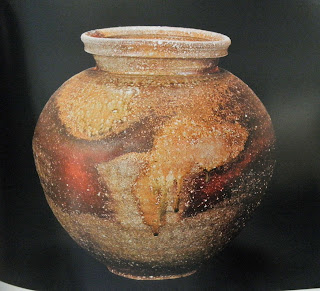




Extraordinary in one word to describe the current exhibition at the Musee Tomo Museum in Tokyo being held until Nov.7th. The long title of the exhibit is 'The Musee Tomo Prize: Contemporary Ceramics for the Tea Ceremony--Free Creativity and Atypical Usage.'Indeed a very appropriate title as the exhibition of 29 invited ceramic artists does indeed straddle the very traditional with forms that one has to wonder how they can actually fit in a chashitsu tea room. For the former I draw attention to the first chawan that greets one as they descend into the darkened, mysterious cavern that is the museum; the chawan being a rusty orange Shino by Living National Treasure Suzuki Osamu (the harmony of emerald matcha and the chawan tones are supreme). The works that challenge one to think of a chashitsu would be Akiyama Yo' powerful black sculptures that would most likely overpower the intimate and quiet space that a chashitsu is; nonetheless brilliant work once again by Akiyama, who also was one of the five recipients of the Tomo Prize, the other four being Suzuki, Ogawa Machiko, Tokusawa Moritoshi and Fukami Sueharu. The foreword from the catalog, " We have had the pleasure of holding the Musee Tomo Prize: Contemporary Ceramics for the Tea Ceremony--Free Creativity and Atypical Usage every other year since 2006. This exhibition invites contemporary Japanese ceramists to create ceramics for the tea ceremony with a free spirit in an attempt to have a view of the way the tea ceremony should be in the 21st century. On the occasion of this third exhibition, the title has been revised to The Musee Tomo Prize: Contemporary Ceramics for the Tea Ceremony--Free Creativity and Atypical Usage and 29 artists submitted their works. Tea drinking was introduced from China and developed uniquely into the tea ceremony, an important Japanese culture. At its zenith in the Momoyama period, Sen no Rikyu perfected wabicha and amidst the teahouse far removed from our daily life emerged a non-routine world. Imagine the host and his guests in conversation triggered through the utensil selected especially for that occasion. Carefully selected ceramics full of ingenuity responded to the expectations of the tea masters and connoisseurs. By touching the ceramic body with our hands, appreciating the look of the glaze, and enjoying the new shapes, to this day, we continue to be enchanted by the refreshing charms of such ceramic containers produced by the artist putting his or her aesthetic into them. Nowadays, tastes and preferences have become diverse and we have to admit that the tea ceremony is on the decline. Yet, there is something beyond nostalgia that never ceases to attract us. In this exhibition, while looking far back on the history of the tea ceremony, we hope to explore the contemporary beauty of free creativity and atypical usage." They--the organizers--have succeeded in flying colors; from the many chawan on display--highlights being chawan by Raku, Ogawa, Ichino Masahiko, Kaneta Masanao and Maeta Akihiro to the wild creations of Akiyama, Yanagihara Mutsuo's mizusashi to the large orbs by Uchida Koichi--this exhibition is must see--I know I'll be going back again and will also gather some groups to give a gallery talk so please let me know if in Tokyo--to see an exhibition that brings the beauty of Tea vessels to a magnificent new level. (Photos seen here are courtesy of the Musee Tomoo and all are copyrighted and cannot be used or reproduced without permission. They are Raku KichizaemonXV's Black Raku Chawan,2010, 11.2cm.tallx14.2x12.2; Yanagihara Mutsuo's Flowing water container, 2010, 29.2cm.tallx29.8; Akiyama Yo's Untitled, MV-104, 2010, 25.5cm.tallx58.5x54.5; Maeta Akihiro's white porcelain faceted Tea bowl, 2010, 10.1cm.tallx12.2 and Imaizumi Imaemon's Tea bowl with spirea design of sumihajiki, 2010, 7.9cm.tallx9.5). A complete list of exhibitors is Kato Kiyoyuki, Suzuki Osamu, Morino Taimei, Yanagihara Mutsuo, Koie Ryoji, Ito Sekisui, Koike Shoko, Tokusawa Moritoshi, Okada Yu, Ogawa Machiko, Takagaki Atsushi, Fukami Sueharu, Nishihata Tadashi, Maede Masahiro, Raku Kichizaemon, Kakurezaki Ryuichi, Kaneshige Yuho, Kawase Shinobu, Ito Tadashi, Akiyama Yo, Kaneta Masanao, Maeta Akihiro, Kitamura Junko, Sakiyama Takayuki, Mihara Ken, Ichino Masahiko, Imaemon Imaizumi, Uchida Koichi and Kato Takahiro. (There is a nice catalog--as noted--one can be ordered from the museum or email Robert through www.japanesepottery.com The Musee Tomo's HP in Japanese only:http://www.musee-tomo.or.jp/)











